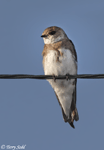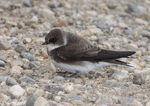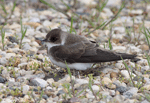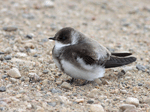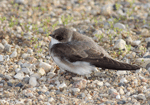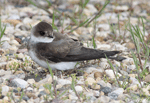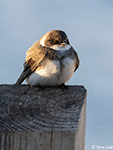Bank Swallow
Riparia riparia
| Length: 4.75 inches | Wingspan: 10.5 inches | Seasonality: Summer |
| ID Keys: Chocolate brown upperparts, white underparts with brownish band across chest. | ||
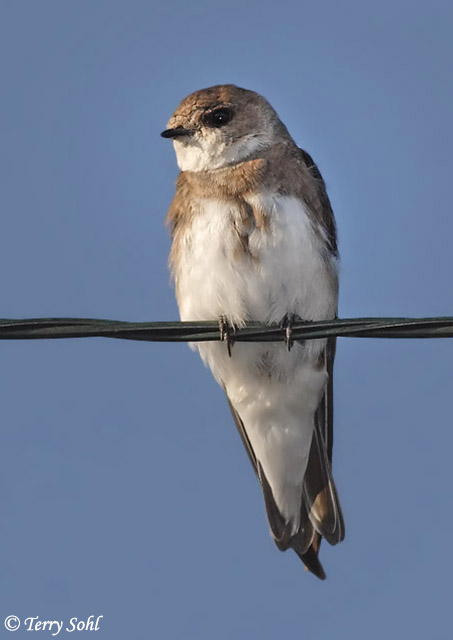 The
Bank Swallow is the smallest of the swallows found in South Dakota.
Strongly associated with water bodies, they can often be found in colonies of
nest burrows numbering up to 1000. Despite their small size and tiny feet
and bill, they build their own nest burrows which may reach 3 or more feet into
the bank.
The
Bank Swallow is the smallest of the swallows found in South Dakota.
Strongly associated with water bodies, they can often be found in colonies of
nest burrows numbering up to 1000. Despite their small size and tiny feet
and bill, they build their own nest burrows which may reach 3 or more feet into
the bank.
Bank Swallows are cosmopolitan, found throughout North America and Eurasia, with migrating birds spending the North American winters in the tropics or in the southern Hemisphere. In other parts of their range they are primarily known as the "Sand Martin", or in Asia, the "Collared Sand Martin", given their trademark dark breast band.
Habitat:
Generally found near water, both during breeding and in migration. Nesting sites are vertical banks of dirt or sand, nearly always right along a water body.
Diet:
Feeds exclusively on insects, nearly always on flying insects which are caught in flight.
Behavior:
Forages almost exclusively by catching insects in flight. Much of their in-flight foraging is quite low over water bodies, signaling their preference for some insect species associated with water. Very gregarious, often found in large nesting colonies.
Nesting: June and July. Bank Swallows nest in colonial burrows, typically built in the side of a vertical bank with loose and sandy soil to facilitate burrowing. The male constructs the nest burrow, and for a bird tiny tiny feet and a tiny bill, he uses them to construct a nest burrow that may reach more than 2 feet into the side of the bank, with a larger nesting chamber at the far end. He then "advertises" his newly constructed home by flying around in front of the burrow, waiting for a female. A female flies in and may check out multiple burrows (and their owners) before selecting a mate.
The female builds a nesting platform within the nest burrowing, lining the floor with grasses, weed stems, roots, or leaves. She lays between 3 and 6 eggs, and both parents help to incubate them. The young hatch after about 2 weeks, and the young fledge from the nest about 16-20 days after hatching.
Interactive eBird Map:
Click to access an interactive eBird map of Bank Swallow photos
Song:
The typical call is a harsh buzzing, or a series of chattering buzzy notes.
- Click here to hear the chattering alarm call of a Bank Swallow1
- Click here to hear the harsh buzzing calls of a Bank Swallow2
- Click here to hear a chattering call/song of a Bank Swallow3
Migration:
Summers throughout much of the U.S. and southern Canada. Winters in South America. In South Dakota they are summer breeding residents throughout the state, migrating southward for the winter.
Similar Species:
Bank Swallows aren't likely to be confused with some swallow species, such as Cliff Swallows or Barn Swallows, as those species have glossy blue backs (and other plumage characteristics) that easily distinguish them from Bank Swallows. However, Bank Swallows could potentially be confused with the following swallow species:
- Northern Rough-winged Swallow - Northern Rough-winged Swallows are very similar in appearance to a Bank Swallow, with dingy gray upperparts and white underparts. However, Northern Rough-winged Swallows lack the dark band across the upper breast.
- Tree Swallow - Adult/mature Tree Swallows are unlikely to be confused with Bank Swallows, but first-of-year juveniles could be, as they are brown above and white below. However, juvenile Tree Swallows lack the dark band across the upper breast.
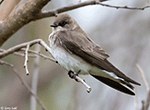 |
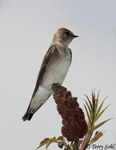 |
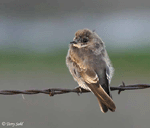 |
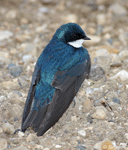 |
| Northern Rough-winged Swallow | Northern Rough-winged Swallow | Tree Swallow (juvenile) | Tree Swallow (adult) |
Conservation Status:
Systematic surveys over the last few decades show modest declines in overall populations. However, they are still found across a very broad geographic area, and are common in parts of that range. The IUCN considers the Bank Swallow to be a species of "Least Concern".
Further Information:
Photo Information:
May 2nd, 2010 - Near Lake Thompson, Kingsbury County, South Dakota -- Terry L. Sohl
Additional Photos:
Click on the image chips or text links below for additional, higher-resolution Cliff Swallow photos.
Audio File Credits
- 1Tanguy Lois. Recorded in France on June 24th, 2020. Original recording and information available from xeno-canto.
- 2Bruce Lagerquist. Recorded in Douglas County, Washington on May 8th, 2020. Original recording and information available from xeno-canto.
- 3Terje Kolaas. Recorded in Norway on July 6th, 2015. Original recording and information available from xeno-canto.
| Click on the map below for a higher-resolution view |
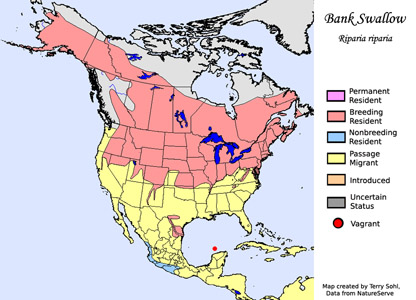 |
| South Dakota Status: Common summer breeder in the eastern part of the state, uncommon in the west. |
Additional Bank Swallow Photos
Click for a higher-resolution version of these photos
